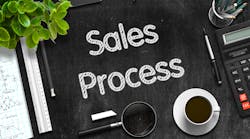Distributors are reworking the blueprint of customer solicitation with value-based selling. Part two of five.
The blueprint for the distributors' sales force hasn't really been reworked for years, but changes are imminent. If you read the first installment, you're probably curious enough to plow through part two of this series. To re-cap, the first article proclaimed that the distributors' sales force hasn't changed much over the years. In fact, the geographic-type sales force hasn't changed much since distribution's beginnings 75 to 100 years ago. Even designations of technical, new account or relationship management of the industrial sales force, which are at least 30 years old, have not changed much. Given the changes of other disciplines in distributorships, what is the new model for distributors and what are the practical methods to apply them?
The term value-based selling is popular now. Sellers with superior product knowledge and application insight can demonstrate product value and secure the order for more money. Unfortunately, much of this talk falls into the service trap of a distributor adding service value to a commodity or intensely distributed product, pricing the product, getting shopped on it, and then not getting paid for the value. “Value selling,” according to popular jargon, is primarily consultative selling.
As we reviewed in the first installment, consultative selling is only fruitful if you make the sale. Otherwise it is a competitive disadvantage because the “value” salesperson informs the customer who then shops the product price. The cost of the consultative salesperson reflects a higher cost of resale. For consulting value to be truly valued, it has to be separated from the product and priced separately to the customer. Unfortunately, for many distributors deciding which services the customer really values is difficult.
Breaking from the popular definition of value-based selling, instead let's assume that customers know what they value or like, given options. Basically, those that don't see value in the sales call don't want it. Customers who want sales value want it when they need it. Those who cherish the continued value of sales contact are willing to pay for it as an ongoing service. In short, value is not predetermined by consultative selling, but it is offered to the customer in three primary ways: product price without sales support, product price with sales support by transaction, and product price with continuing sales support rolled into it. It is also important to distinguish this line of thinking from existing and potential customers.
The adjacent figure, labeled “Customer-Driven Value Selling Options,” puts the determination of sales value (inside and outside) in the hands of the customer. This is the opposite of geographic selling, which gives the outside seller the decision of calling on the customer whether they want it or not.
In the exhibit, there are three types of customer-driven selling. Customers who don't value a sales call or sales support, customers who want sales support on demand and customers who want sales support in the ongoing relationship. Many sales managers argue that they already have sorted customers into these categories and don't send sellers to accounts that do not buy incrementally more. Too often, however, they confuse account size with value-driven classifications.
In essence, small accounts don't get a sales call while the large accounts do. Often, large accounts don't buy incrementally more, so the sales call becomes a defensive action. In the customer-driven model, small or large accounts get equal options at not having a sales call. The desire for sales support is put in the hands of the customer and not the seller. In short, just-in-case selling is less of a problem since the customer will decide the appropriate level of sales support.
On the vertical axis are service sets, customer needs, and strategy implications for wholesaler management. Looking down the vertical column under No Sales Value (NSV), the need for product knowledge is low since the customer is willing to internalize the function. Essentially, the customer chooses to look through catalogs, Web sites, or hire a product specialist instead of using distributor salespeople to perform the function. In NSV accounts, price sensitivity is high and other service needs are typically low. The overall need for NSV accounts is for the distributor to get the sales cost out and develop alternative methods of allowing the customer to research products. Also, in low-sales value accounts, other services may need to be trimmed or reduced because of the price sensitivity of the customer.
The Sales-Value-When-Needed (SVWN) customer is where the majority of wholesaler accounts fit. Most customers want sales support when they need it and don't want to pay for it as an ongoing service. The challenge to any customer-driven value model is reflecting the level of value in the price. For SVWN customers, putting the price in the product for sales-assisted transactions is the easiest and the best-accepted method. For instance, if an SVWN customer wants help in choosing non-stock items, the inside salesperson chooses the items and, if ordered, puts a higher price on the item to reflect the cost. Problems exist, however, in charging for all sales functions. Billing consultative time can be difficult, and the distributor usually feels that performing research for the customer is a cost of business.
Invoicing customers based on how they buy vs. what they buy will be a key issue in channel decisions over the next decade. Sales and executive management will need to grapple with an acceptable logic to reflect this need. E-commerce and other contact methods will be instrumental in allowing customers alternatives to just-in-case salespeople.
Also integral to developing service value is “tangibilizing” services as fee based. Fee-basing and branding services separates them from the product price and gives the distributor flexibility and a mechanism to align sales support for those who want it.
The final column of Sales Value Integral to Ongoing Relationship (SVOR) is for the customer who wants regular sales calls, values customer relationship activities, and is willing to have just-in-case salespeople. Most distributors would consider these accounts their 20/80 customers. They are the larger, more profitable customers who don't put price forward as the key to the value proposition. Although there are customers like this, as the world turns to value selling many distributors will be disappointed to learn their 20/80 customers have switched to the competition, which gives them options and price differences on methods and types of sales support.
The SVOR customer will more likely be kept by creating new value streams, including customized services that answer key hassle factors. The concept of enterprise selling is crucial in the relationship and it ideally involves key members of the supplier (operations, marketing and finance) to become intimately involved in the customer's processes. Although this is done in distribution, it is usually done as an account-specific mode of business.
Distributor salespeople, in general, don't create services for SVOR customers as much as they put out fires and back into value creation for a single SVOR customer. The difference between strategic account management and tactical fire fighting in SVOR customers is a real concern in distributor sales management. The sales managers who understand the difference will be better prepared to compete in the future of value-based sales structures.
SELLING AS A “COST OF BUSINESS”
When I recently explained the three options of value selling and offering different prices for the three value propositions to some distributor sales managers, they were quite disturbed. One manager blurted out, “If you give the customer a price break for not seeing our salespeople, then they (the customer) will take the lowest price and never want to see our salespeople again!” My reply was not comforting. I told him that was exactly what value selling was supposed to do since the customer had a meaningful choice of whether to use the salespeople or not.
Too often I am given the argument that selling is a cost of doing business and that the distributor must have salespeople whether the customer values them or not. In truth, part of the argument is valid because the firm should have salespeople who add value or bring in new streams with new customers. The debate is a matter of degree over the need for salespeople as decided by the existing customer. In short, salespeople will always be needed but how and where they will be used is, in large measure, decided by the customer; the “just in case” salesperson is diminished in scope.
Keeping qualified salespeople is key for the distributor. In this sense, selling is a cost of business as much as having qualified accountants, marketers and warehouse people. Selling, however, unlike the previous functions is much too expensive to keep around “just in case.” In the first part of this series, the cost of inside and outside sales support was given at close to 40 percent of operating expenses. Additionally, sales costs can't be smoothed over multiple transactions like other functional disciplines. For this reason, the ability to give an online, low-cost transaction is financially very attractive for some customer. Salespeople are assets and future leveraging of these assets will be gained by value-based sales options in the very mature markets of distributing.
Value-based options must be delivered in the form of price differentials. If the cost of inside and outside sales support is 40 percent of operating expenses or 8 percent of total expenses, then a NSV customer would ideally get an 8 percent price break for online ordering. Of course, this won't happen because some of the savings in transaction expense will be needed to fund and upkeep the e-commerce capability.
But don't be surprised if a good portion of the transaction savings can be forwarded to the customer. For SVWN customers, the different types of sales supports can either be rolled into the product price or separated and billed as consultative service charges. And, for the SVOR customer, the relationship has to be structured so that continual value-generating projects are approved by the supplier.
In summation, the concept of value-based selling is not about more highly capable salespeople delivering more value to the customer whether they want it or not. It is about developing mechanisms and prices that reflect the customer's need for sales assistance and putting the decision in the hand of the customer. The thinking is in large measure, about delivery of new channels that reflect multiple transaction choices with clear, demonstrable economics. The line of thinking, in my estimation, is needed but will be far from popular. Why? Because distribution is still a sales culture, and anything that attempts to change the model will meet with resistance. In future installments, we will review some very profitable and fast-growing value-added models that will help in your personal quest to further leverage the sales force.
Scott Benfield is a consultant on marketing and sales strategy for distribution. He can be reached via phone at (630) 428-9311 or via e-mail at [email protected].







